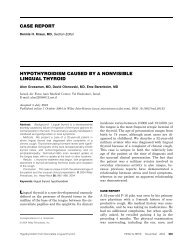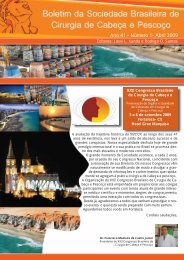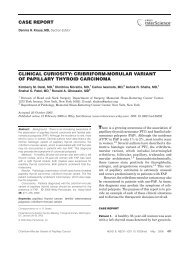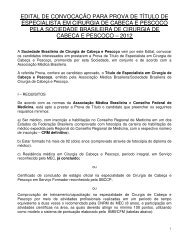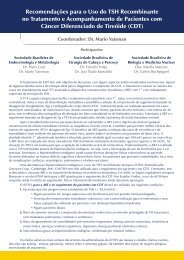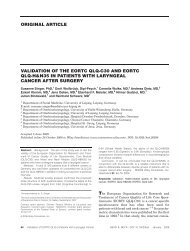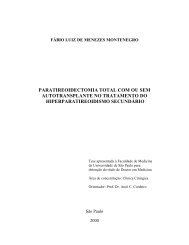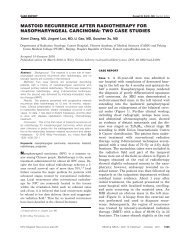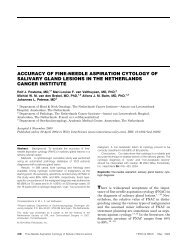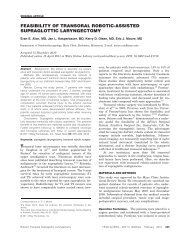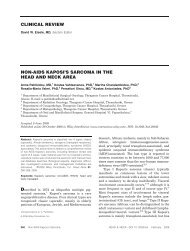The temporal bone: A manual for dissection and surgical approaches
The temporal bone: A manual for dissection and surgical approaches
The temporal bone: A manual for dissection and surgical approaches
You also want an ePaper? Increase the reach of your titles
YUMPU automatically turns print PDFs into web optimized ePapers that Google loves.
BOOK REVIEWS<br />
Karen T. Pitman, MD, Section Editor<br />
THE TEMPORAL BONE: A MANUAL FOR DIS-<br />
SECTION AND SURGICAL APPROACHES<br />
By Mario Sanna, Thieme, New York, New York, 2006,<br />
144 pp, $99.95<br />
This atlas <strong>and</strong> instruction <strong>manual</strong> is designed to aid<br />
both the novice <strong>and</strong> experienced surgeon in <strong>temporal</strong><br />
<strong>bone</strong> <strong>dissection</strong>. It features a nice combination of clearly<br />
labeled photographs of cadaveric <strong>temporal</strong> <strong>bone</strong> <strong>dissection</strong>s,<br />
some of which include appropriately dyed vascular<br />
structures, <strong>and</strong> written text with associated schematic<br />
diagrams where applicable. Although the quality<br />
of the schematics is not as good as that of some other<br />
atlases, such as Jackler’s companion atlas to the Neurotology<br />
textbook, this book makes up <strong>for</strong> this deficiency<br />
by its excellent photo quality. <strong>The</strong> work provides a welcome<br />
addition to available <strong>temporal</strong> <strong>bone</strong> atlases, such<br />
as the classic <strong>temporal</strong> <strong>bone</strong> <strong>surgical</strong> <strong>dissection</strong> <strong>manual</strong><br />
by Ralph Nelson, <strong>and</strong> also the recent second edition of A<br />
Guide to Temporal Bone Surgery by Dr. Marcus Atlas<br />
from Australia. <strong>The</strong> latter text also provides well-labeled<br />
photographs of cadaveric <strong>dissection</strong>s, some of<br />
which are larger than those in the work under review.<br />
However, <strong>The</strong> Temporal Bone has many more photos<br />
<strong>and</strong> better in-depth discussion.<br />
In summary, <strong>The</strong> Temporal Bone: A Manual <strong>for</strong> Dissection<br />
<strong>and</strong> Surgical Approaches is the best <strong>temporal</strong><br />
<strong>bone</strong> atlas currently available <strong>and</strong> seems to be fairly<br />
reasonably priced at $99.00.<br />
ANTHONYA. MIKULEC, MD<br />
St. Louis, Missouri<br />
MINIMALLY INVASIVE TECHNIQUES OF OCU-<br />
LOFACIAL REJUVENATION<br />
By Stephen Bosniak, Marian Cantisano-Zilkha, Thieme<br />
Medical Publishers, New York, 2005, 183 pp, $139.95<br />
Head & Neck 29: 301–302, 2007<br />
Published online 12 December 2006 in Wiley InterScience<br />
(www.interscience.wiley.com).<br />
DOI: 10.1002/hed.20555<br />
' 2006 Wiley Periodicals, Inc.<br />
This 183-page text contains chapters from 22 different<br />
authors from the fields of ophthalmology, dermatology,<br />
plastic surgery, oral surgery, applied biology, cosmetic<br />
dentistry, <strong>and</strong> facial plastic surgery. Few texts exist on<br />
this subject with as broad a spectrum of contributors as<br />
this text has. <strong>The</strong> multidisciplinary approach is one<br />
of the strengths of this book. <strong>The</strong> sections were somewhat<br />
oddly arranged: Noninvasive Approaches, Less<br />
Surgical Invasive Approaches, Perioral Rejuvenation,<br />
<strong>and</strong> Complementary Treatment Modalities. I also found<br />
it strange that a text with this title had a separate section<br />
on perioral rejuvenation <strong>and</strong> not periorbital rejuvenation.<br />
<strong>The</strong> precept of this text is to provide the reader with<br />
the most current in<strong>for</strong>mation on the multitude of minimally<br />
invasive techniques <strong>for</strong> facial rejuvenation, a difficult<br />
task in that the current rate of change in the technology<br />
in this area makes in<strong>for</strong>mation outdated be<strong>for</strong>e<br />
the ink dries. Having said that, I believe this text does a<br />
very good job of providing the most current in<strong>for</strong>mation<br />
at the time that it was written. <strong>The</strong> chapters on fillers,<br />
fat transfer, IPL <strong>and</strong> RF technologies are very good <strong>and</strong><br />
have a lot of detail given the short length of the chapters.<br />
In general, the photography is good, although a<br />
few chapters (eg, chapter 1) have problems with varying<br />
backgrounds, head position, <strong>and</strong> lighting, or pixelization<br />
(eg, chapter 13). Illustrations are used variably in<br />
many of the chapters but are particularly good in chapter<br />
10, ‘‘Endoscopic Forehead Rejuvenation.’’ Chapters<br />
14 to 16 constitute the section on Perioral Rejuvenation.<br />
<strong>The</strong>y are brief but concise <strong>and</strong> cover the basics, particularily<br />
chapter 16, ‘‘Teeth <strong>and</strong> the Perioral Region.’’ <strong>The</strong><br />
section on Complementary Treatment Modalities consists<br />
of 2 chapters <strong>and</strong> an appendix, including ‘‘Photodynamic<br />
<strong>The</strong>rapy <strong>for</strong> Scarless Removal of Multiple Facial<br />
Precanceroses <strong>and</strong> Superficial Carcinomas.’’ Although<br />
this is a topic that is current <strong>and</strong> important, it seems<br />
more likely to be found in a text on cutaneous malignancy<br />
than one on rejuvenation. Granted, one of the<br />
‘‘side-effects’’ of photodynamic therapy is often cosmetic<br />
improvement in skin quality. I found chapter 18, ‘‘Traditional<br />
Chinese Medicine: Its Approach to Facial<br />
Beauty,’’ to be an interesting introduction to facial acupuncture<br />
as a means of facial rejuvenation, a subject I<br />
Book Reviews HEAD & NECK—DOI 10.1002/hed March 2007 301
knew nothing about be<strong>for</strong>e reading this text. <strong>The</strong> appendix,<br />
‘‘Rejuvenating the Skin from the Inside Out,’’<br />
takes a ‘‘you are what you eat’’ approach to the subject<br />
that is a good conclusion to the subject matter.<br />
Overall, I found the book an interesting <strong>and</strong> in<strong>for</strong>mative<br />
look at the current state of affairs in facial rejuvenation.<br />
<strong>The</strong> short nature of the text makes it neither<br />
comprehensive nor inclusive. I think this text would be<br />
an interesting addition to an already well-populated<br />
bookshelf, but <strong>for</strong> those looking <strong>for</strong> a more introductory<br />
or comprehensive reference, I would recommend one of<br />
the more weighty texts on facial plastic surgery or dermatology.<br />
For more current in<strong>for</strong>mation on this rapidly<br />
changing l<strong>and</strong>scape, one will need to either consult the<br />
current dermatology <strong>and</strong> plastic surgery journals or<br />
attend one of the many national meetings that cover the<br />
subject in an almost real-time fashion.<br />
J. RANDALL JORDAN, MD, FACS<br />
Jackson, Mississippi<br />
ANATOMICAL PRINCIPLES OF ENDOSCOPIC<br />
SINUS SURGERY: A STEP BY STEP APPROACH<br />
By Renuka Bradoo, Taylor & Francis CRC Press, Boca<br />
Raton, Florida, 2005, 128 pp, $99.95<br />
<strong>The</strong> text book Principles of Endoscopic Sinus Surgery,<br />
A Step by Step Approach is a presentation of the<br />
basic sinus anatomy, endoscopic anatomy, <strong>and</strong> sinus CT<br />
scan anatomy. As the author states in her conclusion,<br />
‘‘This book is really <strong>for</strong> my junior colleagues <strong>and</strong> <strong>for</strong> all<br />
those who are starting out in endoscopic surgery....’’<br />
<strong>The</strong> chapters are concise, straight<strong>for</strong>ward, <strong>and</strong> easily<br />
readable in a short period of time. Each chapter is<br />
specific <strong>and</strong> contains clear-cut topic in<strong>for</strong>mation in the<br />
text. Much of what is presented has been described by<br />
other authors such as Stammberger, Kennedy, <strong>and</strong><br />
Kuhn. This book conveniently provides such in<strong>for</strong>mation<br />
summarized in 1 source.<br />
Un<strong>for</strong>tunately, the book falls short in the photographs<br />
<strong>and</strong> diagrams that accompany the text in 2 of<br />
the chapters. In chapter 2, ‘‘Osteology,’’ the photographs<br />
of the various <strong>bone</strong>s that <strong>for</strong>m the lateral nasal wall <strong>and</strong><br />
sinuses are clear <strong>and</strong> well lit. However, these are unlabeled<br />
photographs <strong>and</strong> provide no in<strong>for</strong>mation about<br />
anatomic position or relationships to the surrounding<br />
bony structures. This may be confusing to the novice.<br />
<strong>The</strong>se photographs contain artistic appeal without serving<br />
as a true compliment to the chapter.<br />
Many of the cadaveric photographs in chapter 3,<br />
‘‘Lateral Nasal Wall,’’ are presented with adjacent line<br />
drawings. <strong>The</strong>se labeled line drawings are intended to<br />
explain the anatomy in the unlabeled photographs.<br />
Instead, they are poor black-<strong>and</strong>-white outlined renditions<br />
of the photographs. <strong>The</strong>re is scant shading <strong>and</strong><br />
no coloring <strong>for</strong> a sense of dimension, making it difficult<br />
to appreciate the anatomy these drawings are meant<br />
to represent. This is in contrast to the few cadaveric<br />
pictures with labels <strong>and</strong> schematic diagrams seen in<br />
both chapters that appropriately augment the narrative.<br />
A more successful match between the text <strong>and</strong><br />
labeled radiographs is seen in chapter 5, ‘‘Radiological<br />
Anatomy.’’<br />
<strong>The</strong> accompanying DVD supplements the chapter<br />
on endoscopy, which would be lacking otherwise. <strong>The</strong> 3-<br />
dimensional anatomic relationships so integral to<br />
underst<strong>and</strong>ing nasal <strong>and</strong> sinus endoscopy are hard to<br />
appreciate with the still photographs alone as provided<br />
in the chapter. <strong>The</strong> DVD provides a recorded video supplement<br />
<strong>for</strong> the explanation of an endoscopic examination<br />
<strong>and</strong> the pertinent points to endoscopic surgery. A<br />
<strong>dissection</strong> of a cadaveric specimen is shown with accompanying<br />
narration of the steps per<strong>for</strong>med in endoscopic<br />
sinus surgery by the author. Endoscopic dacryocystorhinostomy<br />
is also demonstrated.<br />
Other chapters are also in<strong>for</strong>mative. <strong>The</strong> inclusion<br />
of a chapter on developmental embryology is a suitable<br />
way to begin a book about the study of nasal <strong>and</strong> sinus<br />
anatomy. A later chapter addresses anatomic variations<br />
separate from the discussion on basic anatomy.<br />
Presenting the in<strong>for</strong>mation in this manner provides a<br />
simple way <strong>for</strong> the reader new to sinonasal anatomy to<br />
absorb the complexities of these structures. <strong>The</strong> book<br />
ends with a summarizing chapter describing <strong>surgical</strong><br />
anatomy.<br />
In summary, the major positives of this text book<br />
are that it is concise, readable in short time, <strong>and</strong><br />
well-organized <strong>and</strong> contains appropriate subjects <strong>and</strong><br />
in<strong>for</strong>mation <strong>for</strong> those new to sinonasal anatomy <strong>and</strong><br />
endoscopic sinus surgery. <strong>The</strong> major negatives are<br />
that the unlabelled pictures <strong>and</strong> photographs in the<br />
book are not as helpful as they should be. <strong>The</strong> reader<br />
would have to already know the anatomy to appreciate<br />
their in<strong>for</strong>mation. More importantly, the book<br />
does not contain reference listings <strong>for</strong> further study.<br />
In her preface, the author states, ‘‘...to be a safe but<br />
effective endoscopic sinus surgeon one needs to have a<br />
very strong foundation of anatomy.’’ Overall, this book<br />
provides a good way to begin achieving that recommendation.<br />
This text book will serve best as a potential reference<br />
text <strong>for</strong> residents, those new endoscopic sinus<br />
surgery, <strong>and</strong> those who want a rudimentary study of the<br />
anatomy relevant to endoscopic sinus surgery.<br />
STEPHANIE JOE, MD<br />
Chicago, Illinois<br />
302 Book Reviews HEAD & NECK—DOI 10.1002/hed March 2007



